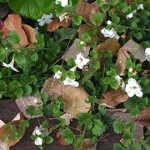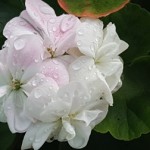This Year, Grow A White Garden
Vita Sackville-West, prolific English author, poetess, and avid gardener described her now-famous white garden at Sissinghurst in Kent as a garden of gray, green, and white. She wrote a column about it in the Observer that was published January 22, 1950 and republished in 2009. See, https://www.theguardian.com/lifeandstyle/gardening-blog/2009/jan/22/gardens
Vita Sackville-West hoped her experiment would be successful. Still, she opined that a garden can look well enough on paper but can fail “after you tuck your plans into the soil.” You can only hope it will turn out well.
Indeed, her garden succeeded as she had hoped. It has garnered worldwide fame as the “white garden at Sissinghurst,” one of the most visited areas of the castle gardens. Her vision for it was quite simply a fairly large bed divided into halves by a paved walkway that ended with seating for visitors to sit facing the garden. Rising at their backs would be a really high hew hedge.
She envisioned many fragrant and ravishing florals sticking up through gray-green foliage. Her chosen blooms for this white garden, best experienced beneath a full moon for its appearance and scent, included dozens of tall trumpets of white Regale lilies, peonies, and irises, in hues of white to the palest creamy yellow.
In creating her garden, Sackville-West was manifesting a hoped-for result. She considered her garden as an amusing exercise and encouraged others to experiment in their gardens as well, according to their own “taste” and “opportunities.”
If you’d like to create a white garden, search for plants in white-blooming varieties and choose some for their fragrance: cleome (attracts pollinators), dianthus, primrose, evening stock (a scented annual whose fragrance intensifies at twilight), lily, phlox, night-blooming jessamine (possesses an intoxicating scent), tuberose, geranium, and white rose.
For gray-green foliage under these plants, tuck in lambs ears, snow-in-summer, or artemisia (this genus has between 200 and 400 plants). Or, use the plants Sackville-West chose for edging–specifically, Dianthus Mrs. Sinkins and Stachys Lanata).
For a small space, why not create a circular bed. Plant a fragrant, white rose, perhaps Claire Austin, named for the English rose breeder David Austin’s daughter. In a circle around the rose, plant yarrow with silvery-gray foliage. In the next layer (furthest from the rose and shortest) use bacopa, alyssum, or other white edging plants to create the outermost circle around the yarrow. The trio of layers in constant bloom creates a lovely bed with the appearance of a fairy ring–dramatic under the moonlight.
________________________________________________________
If you enjoy reading about gardening, keeping bees and chickens, and other rural topics and you like a good mystery, check out my Henny Penny Farmette series of cozies, including A BEELINE TO MURDER, THE MURDER OF A QUEEN BEE, and A HIVE OF HOMICIDES.
- All available online and in bookstores everywhere
A HIVE OF HOMICIDES
MURDER OF A QUEEN BEE
A BEELINE TO MURDER
Enrich your reading pleasure by putting on your muck boots and stepping into the world of Abigail Mackenzie and her coterie of friends in charming Las Flores, California where the local movie theater still serves up homemade pastries and locals gather at the only watering hole in town, the Black Witch.
Besides offering a cozy mystery to solve, these books are chocked full of
1. Delicious recipes
2. Farming and gardening tips
3. Facts and tips for keeping bees and chickens
4. Tidbits of farm wisdom
________________________________________________________
My newest nonfiction books include:

More than 150 rituals for sound mind, strong body, and meaningful connections to the people around you
- Anyone can find peace, clarity, and focus…all it takes is a moment
Tags: artemisia, Claire Austin rose, cleome, David Austin, dianthus, evening stock, gardener, geranium, Kent, lambs ears, lily, night-blooming jessamine, Observer, phlox, poetess, primrose, Sissinghurst Castle, snow-in-summer, tuberose, Vita Sackville-West, white garden, whote rose
 Facebook
Facebook Goodreads
Goodreads LinkedIn
LinkedIn Meera Lester
Meera Lester Twitter
Twitter









